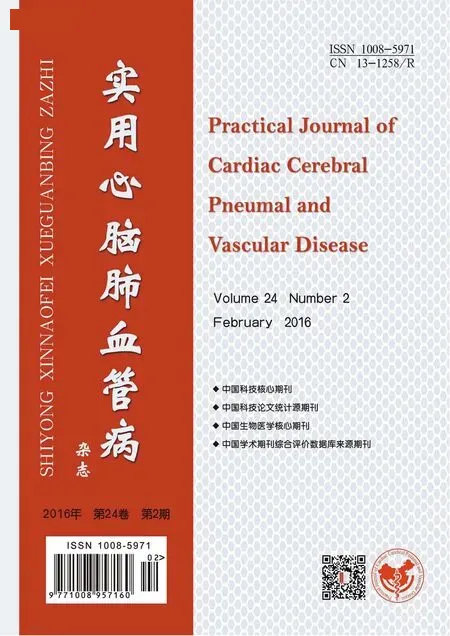血管危险因素与阿尔茨海默病关系的研究进展
闫超群,刘 艺,林丽婷,石广霞,杨静雯,刘存志
·前沿进展·
血管危险因素与阿尔茨海默病关系的研究进展
闫超群,刘 艺,林丽婷,石广霞,杨静雯,刘存志
随着我国人口老龄化进程加剧,阿尔茨海默病(AD)发病率呈逐年增高趋势。目前,AD的确切病因尚未明确,其病理机制复杂,且缺乏有效的治疗措施。世界卫生组织(WHO)强调,早期预防在降低AD发病率中起关键作用。有研究表明,血管危险因素(如高血压、糖尿病、心脏疾病等)可导致认知功能减退,增加AD发病风险。因此,了解血管危险因素与认知障碍的关系有助于阻断或延缓认知障碍向AD发展。本文就血管危险因素与AD关系的研究进展进行综述。
阿尔茨海默病;血管;危险因素;综述
闫超群,刘艺,林丽婷,等.血管危险因素与阿尔茨海默病关系的研究进展[J].实用心脑肺血管病杂志,2016,24(2):1-4.[www.syxnf.net]
Yan CQ,Lin Y,Liu LT,et al.Progress on relationship between vascular risk factors and Alzheimer′s disease[J].Practical Journal of Cardiac Cerebral Pneumal and Vascular Disease,2016,24(2):1-4.
阿尔茨海默病(Alzheimer′s disease,AD)是一种起病隐匿且呈进行性发展的神经退行性疾病,其发病率在全球范围内正快速增长。目前,美国AD患者约530万,且以100万人/年的速度递增,预计到2050年,每33 s将会有一人罹患AD,且65岁以上老年人群AD患病率约为10%[1]。预计到21世纪中叶,中国AD患者将接近2 000万[2]。AD已成为一个严重的社会问题,在美国AD在65岁以上人群死亡原因中位居第五,且AD患者的治疗与护理费用已达2 177亿美元[1]。目前,AD的确切病因尚未明确,其病理机制复杂,且缺乏有效的治疗措施。有研究表明,心脏疾病、糖尿病、高血压等血管危险因素与AD的发病密切相关[3]。本文对血管危险因素与AD关系的研究进展进行综述。
1 心脏疾病与AD的关系
心房颤动(atrial fibrillation,AF)、心力衰竭(heart failure,HF)等严重影响心输出量的心脏疾病常伴有脑组织受损,既能引发血管性痴呆(vascular dementia,VD)[4],又能增加AD的患病风险。有学者认为,心脏疾病是AD发病的一个早期信号[5]。
1.1AF与ADAF是引起认知功能减退的常见病因。Dublin等[6]通过对3 045例65岁以上的社区居民进行14年的随访发现,正常人群AD的发病率为19.7/1 000人年,而AF患者则为38.1/1 000人年,AF患者AD发病风险较正常人群增加40%~50%。Marzona等[7]通过对AF患者随访4年发现,AF患者中简易精神状况检查量表(Mini-mental State Examination,MMSE)评分下降3分者所占比例较正常老年人群多3.5%,其独立日常生活能力评分明显下降者所占比例是正常老年人群的2倍。有研究显示,AF患者通常表现为学习、记忆、注意力和执行能力较差,且伴有海马萎缩[8-9]。分析AF导致AD的可能机制如下:不规则的快速心率可导致短暂性脑缺血发作和脑血流量减少,使脑组织血流灌注不足,导致脑白质疏松或改变;AF的高凝状态还可诱发血栓形成,增加脑梗死的发生风险,并损害脑组织[10-11];AF患者使用抗凝剂后会增加脑内微出血倾向,导致与记忆和空间定位密切相关的海马萎缩,进而加快认知功能减退[12]。
1.2HF与ADHF是引起认知功能减退的一个独立危险因素[10]。与正常人相比,HF患者MMSE评分<24分者数量增加了21%,记忆测试和连线测试评分均较低,且剑桥认知测试评分<80分者数量占70%,因此认知障碍的发生风险更高[13]。HF患者的视空间、执行能力、视觉记忆能力、语言学习能力均较正常人群下降,且存在右侧颞叶萎缩等脑组织结构改变[14]。分析HF导致AD的可能机制如下:HF可导致周围组织灌注不足,脑部血流供应随之下降,进而引起脑白质低灌注、腔隙性脑梗死、内侧颞叶萎缩等,脑组织受损而导致认知障碍;循环血量不充足还会导致多器官功能障碍综合征,HF患者存在多个大脑回路轴突完整性遭破坏和能量代谢障碍;能量代谢障碍可引起酸中毒及氧化应激,导致酶和蛋白质合成障碍;酸性环境会活化溶酶体酶和天冬酰胺内肽酶、抑制磷酸酯酶2A(PP-2A)的活性,使其解除对Tau蛋白过度磷酸化的抑制,酸性环境能上调剪切淀粉样前体蛋白(APP)的β分泌酶活性,以上因素均可增加脑内Tau蛋白缠结和β-淀粉样蛋白(Aβ)聚集,进而导致AD[15]。
2 高血压与AD的关系
有研究显示,约11%的高血压患者存在认知障碍[16]。Ninomiya等[17]通过对668例中年高血压患者随访17年发现,123例患者发展为AD,其中血压正常者AD发病率为2.3/1 000人年,高血压Ⅰ期和Ⅱ期患者AD患病率分别为12.6%和18.9%。动物实验结果表明,高血压模型小鼠脑微血管密度较正常小鼠减少了25%,脑血管淀粉样蛋白沉积增加了30%~40%[18]。高血压可增加脑内Aβ的积累和聚集,携带ApoE4基因型的高血压患者脑内淀粉样沉淀明显增加,且经降压药治疗后明显下降[19]。Shah等[20]通过观察中年高血压患者血浆Aβ、脑内Aβ沉淀与AD的关系发现,舒张压升高可减少血浆Aβ沉淀、增加脑内Aβ沉淀,进而增加AD的发生风险。分析其作用机制可能如下:高血压导致脑血管功能失调或损害,脑内Aβ的清除率降低;长期高血压可导致动脉粥样硬化和微血管病变,脑灌注不足和能量供应障碍导致海马神经元变性、凋亡;同时,高血压还可引起微血管功能障碍和损伤,导致脑白质病变、腔隙性脑梗死、脑组织微出血等,使认知功能减退[21-22]。
3 低血压与AD的关系
与老年高血压患者相比,老年低血压患者更易出现认知障碍[23-24]。Scuteri等[25]通过分析280例认知功能减退(MMSE评分<21分)患者的血管危险因素发现,78.6%的患者合并低血压。有研究显示,直立性低血压会增加AD的发病风险[26],其作用机制可能如下:低血压导致脑血流量下降,脑灌注不足而影响认知功能;导致AD发病的脑部神经变性区域与心血管自主调控的脑部区域在同一脑区,因此这一区域的神经变性既可以影响认知功能,也会导致血压下降;还有学者认为,认知障碍应该是直立性低血压的一个症状而不是其长期影响的结果[27]。老年人常伴有脑动脉粥样硬化等影响血管功能的疾病,且脑血管自动调节机制已受损,低血压会导致脑组织低灌注,损害认知功能[28]。
4 糖尿病与AD的关系
Crane等[29]通过对2 067例65岁以上的老年人进行6.8年的随访发现,糖尿病会增加痴呆患病率,且与血糖正常人群相比,血糖异常人群痴呆的患病率增加了22%。功能核磁共振成像发现,2型糖尿病患者信息处理速度放缓[30],且多数患者伴有脑梗死灶及灰质、白质、海马等体积缩小,灰质萎缩主要分布在内侧颞叶、前扣带回和内侧额叶,白质萎缩分布在额叶和颞叶区域[31]。AD患者脑组织与糖尿病患者周围组织中均有氧化应激、炎症等病理改变,葡萄糖代谢降低可导致Tau氨基糖化修饰作用下降,促进Tau蛋白过度磷酸化,损害细胞维持能量内稳态的能力,破坏血-脑脊液屏障的完整性,导致外周血中炎性递质(如肿瘤坏死因子、白介素6等)渗入脑内;糖尿病可通过改变转运蛋白而增加血-脑脊液屏障的通透性,进而影响脑内神经元营养物质和离子水平[32]。有研究显示,糖尿病患者微血管并发症包括灌注减少、内皮细胞异常增殖和血管通透性增加,以上并发症均可导致脑微血管改变(如管径狭窄),引起脑灌注不足、能量供应障碍,从而加速AD的病理变化。
5 高脂血症与AD的关系
胆固醇代谢在AD的病理生理过程中具有重要作用,血清总胆固醇水平升高可增加AD的发病风险[20],且约10%的AD患者存在血脂异常[33]。胆固醇可通过激活β分泌酶的活性而调节APP的水解过程,在胆固醇耗尽的细胞中可见Aβ的分泌减少和促淀粉样变的APP C-末端片段的产量减少;而这些细胞补充胆固醇后会出现β分泌酶和裂解产物Aβ40、Aβ42的增加[34]。Thirumangalakudi等[35]采用高胆固醇食物喂养小鼠5个月后发现,小鼠基底核胆碱神经元数量明显减少、大脑皮质胆碱能神经递质水平明显降低,说明高水平胆固醇能损伤胆碱能系统。高水平胆固醇可破坏血-脑脊液屏障的完整性,使血浆中蛋白进入脑内,诱导脂蛋白与Aβ结合,还能激活小胶质,使脑内神经免疫炎性因子水平升高[36]。使用他汀类药物治疗后,AD小鼠脑内Aβ沉淀明显降低、神经炎性斑块形成明显减少,且认知功能得到改善[37]。
6 动脉粥样硬化与AD的关系
动脉粥样硬化是一种慢性炎症积累过程,其主要表现为内皮细胞层遭破坏、血管平滑肌细胞增殖和内皮下基质的沉积;动脉粥样硬化斑块的聚集可导致血管渐进性狭窄,其脱落还可增加心肌梗死和脑血管意外的发生。有研究对2 364例无认知障碍的受试者进行动脉硬化钙化评估并随访6年发现,除冠状动脉外所有血管的大体积钙化均会增加认知障碍的发生风险,尤其是颈动脉钙化[38]。对人颈动脉斑块研究后发现,动脉硬化斑块微出血后血小板聚集,激活吞噬细胞吞噬血小板,血小板源性APP水解生成Aβ,并导致诱导型一氧化氮合酶的表达上调[39]。大的斑块可导致血管狭窄、脑血流量降低,使吞噬细胞吞噬功能和脑血流量下降,减少脑内氧和营养物质传递,从而影响APP的蛋白酶水解,使 Aβ异常增多;而Aβ异常沉淀又可减弱血管舒张反应,使脑血管收缩而减少脑血流量,与其神经毒性作用一起协同促使脑血流量下降,损害脑组织、影响大脑功能而导致AD[40]。
7 结语
尽管血管危险因素导致AD发病的具体机制尚待于进一步研究阐明,但其与AD的关系不容忽视。糖尿病、高血压、动脉粥样硬化等血管危险因素均可导致认知功能减退,增加AD的发病率。但由于血管危险因素具有非遗传和可控性的特点,可作为早期预防AD的着眼点,在未出现认知功能减退前提早进行科学管理,进而预防AD的发生。
文献参考
[1]Alzheimer′s Association.2015 Alzheimer′s disease facts and figures[J].Alzheimers Dement,2015,11(3):332-384.
[2]王晶.我国阿尔茨海默病的流行现状及预防措施[J].亚太传统医药,2011,7(2):157-158.
[3]Gorelick PB.Risk factors for vascular dementia and Alzheimer disease[J].Stroke,2004,35(11 Suppl 1):2620-2622.
[4]Cardiogenic dementia[J].Lancet,1977,1(8001):27-28.
[5]Bergmann C,Sano M.Cardiac risk factors and potential treatments in Alzheimer′s disease[J].Neurol Res,2006,28(6):595-604.
[6]Dublin S,Anderson ML,Haneuse SJ,et al.Atrial fibrillation and risk of dementia:a prospective cohort study[J].J Am Geriatr Soc,2011,59(8):1369-1375.
[7]Marzona I,O′Donnell M,Teo K,et al.Increased risk of cognitive and functional decline in patients with atrial fibrillation:results of the ONTARGET and TRANSCEND studies[J].CMAJ,2012,184(6):E329-E336.
[8]Knecht S,Oelschlager C,Duning T,et al.Atrial fibrillation in stroke-free patients is associated with memory impairment and hippocampal atrophy[J].Eur Heart J,2008,29(17):2125-2132.
[9]Wozakowska-Kaplon B,Opolski G,Kosior D,et al.Cognitive disorders in elderly patients with permanent atrial fibrillation[J].Kardiol Pol,2009,67(5):487-493.
[10]Justin BN,Turek M,Hakim AM.Heart disease as a risk factor for dementia[J].Clin Epidemiol,2013(5):135-145.
[11]Muqtadar H,Testai FD,Gorelick PB.The dementia of cardiac disease[J].Curr Cardiol Rep,2012,14(6):732-740.
[12]Jacobs V,Cutler MJ,Day JD,et al.Atrial fibrillation and dementia[J].Trends Cardiovasc Med,2015,25(1):44-51.
[13]Vogels RL,Scheltens P,Schroeder-Tanka JM,et al.Cognitive impairment in heart failure:a systematic review of the literature[J].Eur J Heart Fail,2007,9(5):440-449.
[14]Beer C,Ebenezer E,Fenner S,et al.Contributors to cognitive impairment in congestive heart failure: a pilot case-control study[J].Intern Med J,2009,39(9):600-605.
[15]Cermakova P,Eriksdotter M,Lund LH,et al.Heart failure and Alzheimer′s disease[J].J Intern Med,2015,277(4):406-425.
[16]Knecht S,Wersching H,Lohmann H,et al.How much does hypertension affect cognition?:explained variance in cross-sectional analysis of non-demented community-dwelling individuals in the SEARCH study[J].J Neurol Sci,2009,283(1/2):149-152.
[17]Ninomiya T,Ohara T,Hirakawa Y,et al.Midlife and late-life blood pressure and dementia in Japanese elderly:the Hisayama study[J].Hypertension,2011,58(1):22-28.
[18]Cifuentes D,Poittevin M,Dere E,et al.Hypertension accelerates the progression of Alzheimer-like pathology in a mouse model of the disease[J].Hypertension,2015,65(1):218-224.
[19]Rodrigue KM,Rieck JR,Kennedy KM,et al.Risk factors for beta-amyloid deposition in healthy aging: vascular and genetic effects[J].JAMA Neurol,2013,70(5):600-606.
[20]Shah NS,Vidal JS,Masaki K,et al.Midlife blood pressure,plasma beta-amyloid,and the risk for Alzheimer disease:the Honolulu Asia Aging Study[J].Hypertension,2012,59(4):780-786.
[21]Faraco G,Iadecola C.Hypertension:a harbinger of stroke and dementia[J].Hypertension,2013,62(5):810-817.
[22]Iadecola C.The pathobiology of vascular dementia[J].Neuron,2013,80(4):844-866.
[23]Kennelly SP,Lawlor BA,Kenny RA.Blood pressure and the risk for dementia:a double edged sword[J].Ageing Res Rev,2009,8(2):61-70.
[24]Qiu C,Winblad B,Fratiglioni L.The age-dependent relation of blood pressure to cognitive function and dementia[J].Lancet Neurol,2005,4(8):487-499.
[25]Scuteri A,Tesauro M,Guglini L,et al.Aortic stiffness and hypotension episodes are associated with impaired cognitive function in older subjects with subjective complaints of memory loss[J].Int J Cardiol,2013,169(5):371-377.
[26]Allan LM,Ballard CG,Allen J,et al.Autonomic dysfunction in dementia[J].J Neurol Neurosurg Psychiatry,2007,78(7):671-677.
[27]Perlmuter LC,Sarda G,Casavant V,et al.A review of orthostatic blood pressure regulation and its association with mood and cognition[J].Clin Auton Res,2012,22(2):99-107.
[28]Kim YS,Davis SC,Truijen J,et al.Intensive blood pressure control affects cerebral blood flow in type 2 diabetes mellitus patients[J].Hypertension,2011,57(4):738-745.
[29]Crane PK,Walker R,Hubbard RA,et al.Glucose levels and risk of dementia[J].N Engl J Med,2013,369(6):540-548.
[30]Reijmer YD,Leemans A,Brundel M,et al.Disruption of the cerebral white matter network is related to slowing of information processing speed in patients with type 2 diabetes[J].Diabetes,2013,62(6):2112-2115.
[31]Moran C,Phan TG,Chen J,et al.Brain atrophy in type 2 diabetes: regional distribution and influence on cognition[J].Diabetes Care,2013,36(12):4036-4042.
[32]Hawkins BT,Lundeen TF,Norwood KM,et al.Increased blood-brain barrier permeability and altered tight junctions in experimental diabetes in the rat:contribution of hyperglycaemia and matrix metalloproteinases[J].Diabetologia,2007,50(1):202-211.
[33]Popp J,Meichsner S,Kolsch H,et al.Cerebral and extracerebral cholesterol metabolism and CSF markers of Alzheimer′s disease[J].Biochem Pharmacol,2013,86(1):37-42.
[34]Fassbender K,Simons M,Bergmann C,et al.Simvastatin strongly reduces levels of Alzheimer′s disease beta -amyloid peptides Abeta 42 and Abeta 40 in vitro and in vivo[J].Proc Natl Acad Sci U S A,2001,98(10):5856-5861.
[35]Thirumangalakudi L,Prakasam A,Zhang R,et al.High cholesterol-induced neuroinflammation and amyloid precursor protein processing correlate with loss of working memory in mice[J].J Neurochem,2008,106(1):475-485.
[36]Takechi R,Galloway S,Pallebage-Gamarallage MM,et al.Dietary fats,cerebrovasculature integrity and Alzheimer′s disease risk[J].Prog Lipid Res,2010,49(2):159-170.
[37]Li G,Larson EB,Sonnen JA,et al.Statin therapy is associated with reduced neuropathologic changes of Alzheimer disease[J].Neurology,2007,69(9):878-885.
[38]Bos D,Vernooij MW,de Bruijn RF,et al.Atherosclerotic calcification is related to a higher risk of dementia and cognitive decline[J].Alzheimers Dement,2015,11(6):639-647.
[39]De Meyer GR,De Cleen DM,Cooper S,et al.Platelet phagocytosis and processing of beta-amyloid precursor protein as a mechanism of macrophage activation in atherosclerosis[J].Circ Res,2002,90(11):1197-1204.
[40]Iadecola C.Atherosclerosis and neurodegeneration:unexpected conspirators in Alzheimer′s dementia[J].Arterioscler Thromb Vasc Biol,2003,23(11):1951-1953.
(本文编辑:谢武英)
Progress on Relationship Between Vascular Risk Factors and Alzheimer′s Disease
YANChao-qun,LIUYi,LINLi-ting,etal.
GraduateSchoolofTianjinUniversityofTraditionalChineseMedicine,Tianjin300193,China
As the aggravation of population aging process in China,the morbidity of Alzheimer′s disease increased year by year.At present,the definite etiological factor of Alzheimer′s disease is still not clear,but its pathomechanism is complex,and there is a less of effective treatment so far.WHO once emphasized that early prevention play a key role in reducing the morbidity of Alzheimer′s disease.Vascular risk factors(such as hypertension,diabetes and heart disease)may result in cognitive decrease and increase the onset risk of Alzheimer′s disease.Acquaintance of relationship between vascular risk factors and cognitive disorder is helpful to interdict or delay the process to Alzheimer′s disease.This paper reviewed the progress on relationship between vascular risk factors and Alzheimer′s disease.
Alzheimer′s disease;Blood vessels;Risk factors;Review
国家自然科学基金面上项目(81473501);北京市科技计划课题“首都临床特色应用研究”专项(Z131107002213034);北京市科学技术委员会首都市民健康项目培育课题(Z1311000068132002)
300193天津市,天津中医药大学研究生院(闫超群,刘艺,林丽婷);首都医科大学附属北京中医医院针灸中心(石广霞,杨静雯,刘存志)
刘存志,100010北京市,首都医科大学附属北京中医医院针灸中心;E-mail:lcz623780@126.com
R 745.7
A
10.3969/j.issn.1008-5971.2016.02.001
2015-10-23;修回日期:2016-02-10)
【编者按】阿尔茨海默病由德国著名神经解剖学家和病理学家Alzheimer于1907年首先描述,后人以其姓氏命名。随着我国人口老龄化进程的加剧,阿尔茨海默病作为老年痴呆最常见的一种类型已然成为一个重要的医学和社会问题。闫超群等学者检索大量文献综述认为糖尿病、高血压、动脉粥样硬化等血管危险因素均可导致认知功能减退,增加阿尔茨海默病的发病率,建议作为早期预防阿尔茨海默病的着眼点,敬请参考借鉴!

